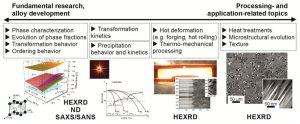Urgent needs concerning energy efficiency and environmental politics require novel approaches to materials design. The rapidly expanding global economic network and increasing mobility create a serious social and political pressure on climate protection issues and a sustainable use of limited natural resources.
In this context, a variety of research programs are launched all over the world in order to substantially reduce emissions from air and automobile traffic. In particular, the European Union provides strict standards regarding the allowed CO2 and NOx emissions from aero-engines as well as automotive engines, which are based on the combustion principle. Furthermore, a noticeable reduction of fuel consumption and noise has to be ensured. In addition to new and improved engine design concepts, innovative structural materials have to be “stronger and lighter” to withstand the extremely high demanding conditions in the next generation of aircraft and automotive engines.
Intermetallic titanium aluminides based on the ordered γ-TiAl phase have attracted increasing interest as innovative high-temperature light-weight structural materials. They already have found application in aerospace and automotive industries as turbine blades of aero-engines, turbocharger turbine wheels for automotive engines or high-performance valves for racing car engines, and are still subject of worldwide research and development activities. Their low density, high specific yield strength and stiffness, good oxidation and creep resistance up to high temperatures perfectly match the engine manufacturers’ demands. The Review in Advanced Engineering Materials of Svea Mayer from the Montanuniversität Leoben and her co-workers bridges the gap from the development of the so-called TNM alloy, which represents a β-solidifying 3rd generation TiAl alloy, through computational materials design, structural characterization with sophisticated in and ex situ methods, engineering properties, manufacturing and processing technologies to all aspects of application.


















